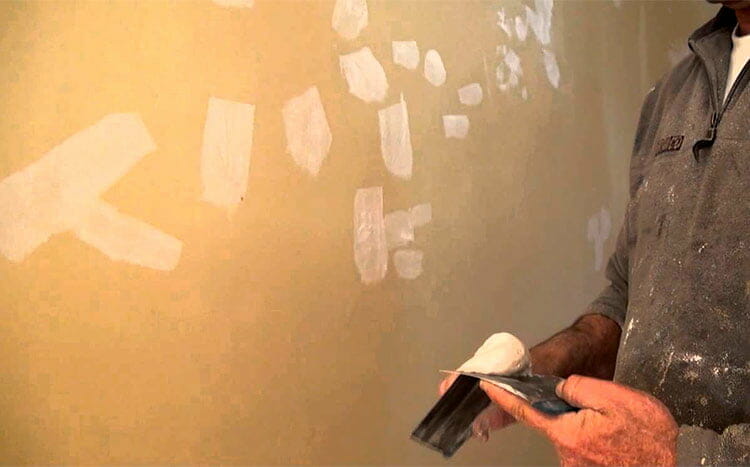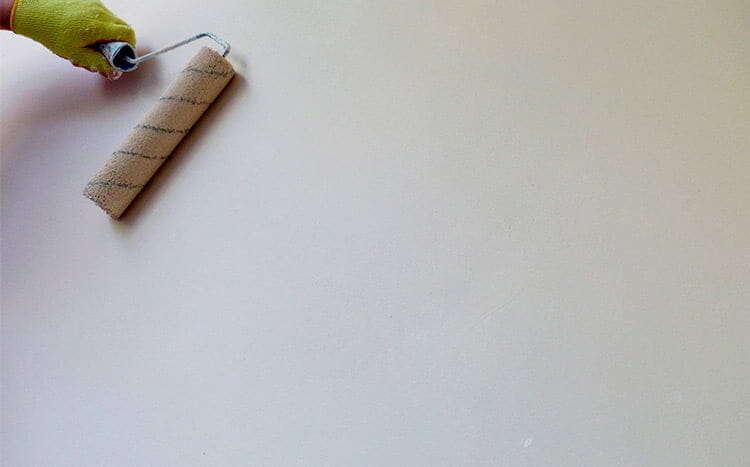If you have successfully installed drywall on your walls, the next step is finishing and painting it. Drywall is easy to work with, but you must make sure you follow the right steps.
You will need to inspect the wall and fill in any dings, scratches, or gaps in the sheets, and fill them with mud. Next sand in a circular motion, clean and prime.
We have some more detailed steps below as well as some handy tips and tricks to get the job done right.
Steps to preparing drywall for painting
Having a smooth and appealing paint job is the desire of every homeowner. To make sure you get the best results, make sure you follow the following steps closely.

Step 1: Inspect
The first step is to inspect your drywall to check whether there are any dings or gouges. Also, look for cracks and gaps in sheets. Mark these so you can come back and fill them with mud.
Step 2: Fill and Sand
You can also DIY your own paste with various online recipes to save money or you can just buy it. Make sure you fill all the holes and gaps well. Mus is super easy to sand later so use as much as you need.
Put on a face mask and use a pole sander and apply light pressure on the walls. Sand the drywall in a circular motion. Side to side sanding may create scratches on the walls.
Step 3: clean the drywall
Mix one cup of white vinegar with a gallon of water in a bucket. Soak a sponge into the water and vinegar mixture and use it to clean the wall thoroughly. Work from top to bottom and divide the wall into small workable sections for easy and fast cleaning.
If the water in the bucket becomes several shades darker before you finish cleaning the wall, make a fresh water-vinegar mixture and repeat the process until the drywall is completely clean.
Step 4: dry the drywall well
The wet drywall should be bone dry before you paint it. To make the drying process faster, direct a fan and set it at the highest speed. Fan drying is important if the air is humid. More so, it makes the drying process faster than leaving the drywall to dry on its own.
Make sure the drywall is completely dry before you paint it. This is because wet drywall can attract mold clusters underneath, which may cause problems in the future.
Step 6: prime and paint
This is the last step, and it should be done when the drywall dries up completely. Priming is important before painting because primer helps the paint adhere better to the wall. Since the drywall is porous, priming makes it suitable for painting. More so, you will use fewer coats of paint when you prime first before painting.
Prime before painting
As mentioned above, it is critical to prime the drywall before painting it. Priming ensures the surface is smooth for painting and helps the paint adhere stronger and better to the wall. Primer also makes the paint last for a long time without cracking or peeling. The steps below will guide you to prepare the drywall for priming.
- Check for dust
Even after thoroughly washing and drying drywall, you may still find some dust. To check for dust, run a soft microfiber cloth over the surface of the drywall. This is to remove any remaining debris and guard the wall against dust. By so doing, you will make the painting work easier and faster.
This process should be done right before applying the drywall primer. Use a high-quality latex primer specially designed for drywall. The primer will effectively seal the wall and ensure the paint absorbs evenly without creating any splotches. It will also protect the walls from small dings and Knicks.
The primer will also reduce the number of coats of paint you will use. It is better to apply primer and two coats of paint than to apply three to four paint coats without a primer. This is because if you do not prime the wall first, the paint will not last long, so you will have to repaint sooner than expected.
- Apply the primer
After running the microfiber cloth over the drywall, you can now apply your primer. Apply the primer just like paint and ensure you cut in around the edges, baseboard, and ceiling. Use a roller to make the application easy and fast.
Apply the primer from top to bottom and work in small sections for accuracy. Make sure you cover every part of the wall. Do not be surprised if the primer dries too fast because drywall is a porous material. You may apply two coats of primer to make sure the drywall is ready for painting.
- Sand if need be
Once the primer dries, run your hand over the drywall surface. If it is rough, you can sand it lightly to make sure the surface is as smooth as you want it to be. Then, run a smooth and clean microfiber rug over the drywall surface before painting.
At this point, your drywall is ready for painting, and ensure you use the right paint for the walls. Also, select a color that interests you to make the space have a personal feel.
Do painters prepare walls for painting?
Yes, professionals will prepare the walls before painting. This will, however, depend on the condition of your walls. For new drywall, sanding and cleaning the walls is necessary before priming and painting. Cleaning removes dirt and dust and helps the wall look better after painting.
Cleaning is also necessary for old walls because of the dirt and dust build-up. Washing the walls removes dust, dirt, and debris. If some sections of the wall have major stains, a special primer will be applied to those areas prior to painting. A professional painter will know the value of washing the walls before painting.

Do I need to use a primer before painting on drywall?
Yes, you need to prime drywall before painting. New drywall is highly porous and the fasteners holes, taped, and mudded seams will still be exposed. So, you need to prime the surface before painting to allow the paint to adhere better. Besides, the primer seals any knicks, dings, and scratches, making the surface smooth.
You may also need to prime an old wall before painting, depending on its condition. If the wall has holes or cracks, you should fill them with mud before painting. Also, you should use a special primer on any stains on the walls.
1 or 2 coats of primer?
The number of coats of primer will depend on the condition of the wall and the type of primer. For new drywall, two coats of primer will be ideal. If the wall is old, you can apply one or two primer coats depending on its condition.
Your painting contractor will know how many coats to apply before painting. If you are DIYing the project, you should consult a professional if you are not sure how many coats of primer you will need. However, most painting jobs need two coats of primer to ensure all scratches are knicks are sealed before painting.
How smoothly does drywall need to be before painting?
For a smooth paint job, you need to ensure your walls are smooth before priming or painting. After taping and mudding, you need to sand the wall to make it smooth. Sanding is a slow, tiring, and dirty process, but the results are worth it.
You can sand the drywall before and after priming it. After applying the primer, leave it to dry and sand all exposed edges. If there are any gouges, cover them with a thin layer of mud and feather it out along the wall. You can apply a second layer of mud if necessary, then feather it out as well. Once the mud is dry, sand it smooth.

Do I need to dust before priming?
Yes, dusting is essential because it removes the dust formed after sanding. You can use a vacuum cleaner and towel to dust the wall. You can even use water and laundry detergent to wash the walls to ensure you get rid of all dust.
If you prime before dusting, the primer will start flaking because of the films of dust left on the wall. More so, the paint will not last long because of the dust films. For this reason, ensure you dust the walls before priming or painting.
FAQ’s
How many coats of mud do you need to finish drywall?
The recommended number of coats of mud you should apply are three thin ones instead of two heavy ones. The joint compound takes time to dry, and you should not rush the drying process by using fewer thicker coats. Make sure the coat dries completely before applying a new one.
Do you have to sand between coats of mud?
Yes, you should sand between coats of mud to make your work easier. You can use a screen sander attached to a pole to do the job. Sanding between coats of mud minimizes the bumps, making your job easier. The sanding should be done when the mud is dry or still drying.
Can I paint directly on drywall?
No, it is not advisable to paint directly on drywall. Once you finish hanging your drywall, you should mud the joints and primer them before painting. Ensure the primer you use is designed for drywall for the best results.
Drywall is very porous, and if you paint it before priming, the paint will not adhere better. The paint may start peeling sooner than expected, especially in humid conditions. More so, cleaning the drywall may be difficult once the paint dries because of a lack of adhesion.
Do I need to remove drywall dust before priming?
Yes, you should remove all the dust before painting. Dust tends to form thin films that may make the paint flake from the surface of the drywall. So, it is advisable to remove drywall dust before you paint to make the paint durable.
You can use a damp cloth to wipe the drywall’s surface. However, since wet cloth may make the surface damp, ensure it dries before priming and painting.
Preparing drywall before painting is essential if you want a smooth finish. Also, the paint will last for a long time when all the necessary steps are observed. Whether you are DIYing the project or hiring a professional painter, ensure the right prepping steps are followed.







